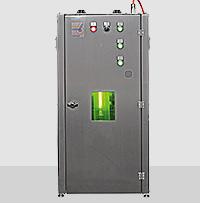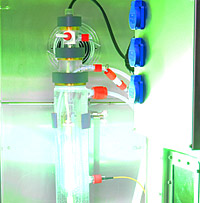The smallest photoreactor from Peschl Ultraviolet can perform nine irradiation experiments in parallel with very small sample quantities – LEDs are thermally decoupled by means of thermoliquid.
The innovative photochemical screening device consists of nine vials (cells), each with a volume of 8 ml, which can be irradiated simultaneously with nine different wavelengths. The intensity of each wavelength can be adjusted to each other, so that even with different efficiencies of the respective LED wavelength, the irradiation intensity can be equated. The LEDs are located in a cassette, which is thermally decoupled from the vials and can be quickly replaced. “Our screening device is the only product on the market in which the LEDs are thermally decoupled by means thermoliquid,” Alexander Peschl emphasizes another special feature of the PX9. Once the optimum wavelength for a defined photochemical process has been determined, the multi-LED cassette can be exchanged, for example, for a cassette with nine identical LEDs, so that further investigations can be carried out, for example to determine the concentration. The cuvettes can be precisely tempered between -20°C and +80°C without the LEDs being affected by condensation, icing or overtemperature. Each LED can also be controlled and dimmed individually by means of a touch panel, and it is also possible to control all LEDs at the same time.
Mixing in the photoreactor is achieved by an oscillating mixing principle, – the screening device is mounted on an oscillating vibrating table. This principle prevents unwanted shear forces from acting on the samples and also irradiates viscous products and products that tend to phase separate.
















